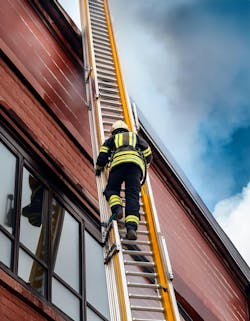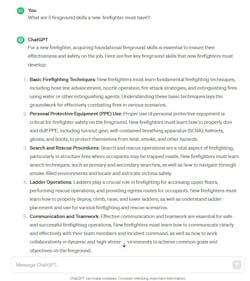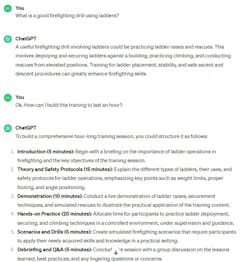Four Uses of AI to Improve Fire Service Training Programs
Artificial intelligence, or AI, has come to the forefront of many discussions that are related to making life easier. It’s expected to influence, if not revolutionize, certain aspects of our life as its integration becomes more widespread.
Although we hear about the promises and growth of AI in our daily life, the fire service already is developing and utilizing AI for fire service means. This includes for fire safety and fire investigation purposes, to alert firefighters of potential wildfire breakouts, to improve response times/avoid traffic issues, to predict firefighter cardiac events, and to model and predict fire behavior in buildings. However, company officers and fire instructors can use AI to improve fire service training.
Use of generative AI
For this article, I focus on just one aspect of AI: generative AI. Generative AI refers to computational techniques to generate new, meaningful content.
In numerous aspects of life, we already interact with generative AI. Webpage chatbots, Microsoft Copilot and OpenAI’s ChatGPT are just three programs by which you already might use generative AI.
In my opinion, the major difference between using ChatGPT versus the Google webpage to search for information is that ChatGPT makes the process feel like an interaction and actually creates something new based on a question or directive. In contrast, Google search results present existing information and still require filtering and deciphering of what’s the best answer.
Because generative AI technology creates relevant and new materials for the user, it can be harnessed to improve and enhance training content while improving the efficiency and effectiveness of the company officer’s or fire instructor’s time. (Generative AI is being used in other training and education realms to increase learner engagement, improve knowledge and skill retention, and advance training effectiveness.)
Most generative AI programs require the user to input a “prompt” to receive an output that makes sense. If you don’t write a good prompt, you won’t receive the output that you desire. By asking the right questions or designing accurate prompts that are related to the training topic, generative AI produces results that are connected to the inquiry. (See “Fire Service Training-Related Generative AI Prompts” below.)
There are free and paid versions of the various generative AI programs. Many of the free programs meet the needs of the fire service user, but investigate what features that you require and decide whether it’s worth it to upgrade to a paid version.
Four uses in fire service training
Save time. Using generative AI to do basic research or to investigate a topic might save time. Instead of searching the web or digging through existing training materials, the user can enter a prompt that relates to a firefighting topic. An example of using ChatGPT to save time might be, “Write 200 words on the evolution of fire apparatus.”
Brainstorm. Generative AI can be used to help to generate training ideas.
We all had those moments of mind-block when we couldn’t think of a training topic for an upcoming session. Common ways to overcome this challenge are to look at past drills, investigate policies/standard operating guidelines, open an NFPA standard, check websites and explore social media. Generative AI offers an additional tool. An example of a prompt to help brainstorm ideas for training might be, “What are 10 knots that a firefighter should know?”
Generate outlines and rough drafts. Once you identify a training session topic, you can use generative AI to create an outline or overview. As noted above, we can use search engines to find existing information, but prompts in generative AI perform the heavy work of building training information. An example of using generative AI to generate training outlines that have a given topic and time-limit considerations is, “Build me an outline for a 15-minute drill on rope rescue knots.”
Create content. A tremendous benefit to company officers and fire instructors is that they can use generative AI to create training content. There are generative AI products that can take text and create pictures (CoPilot Designer, DALL·E 3, Midjourney, Stable Diffusion), videos (Lumen5, Pictory, Sora), handouts (ChatGPT), infographics (Canva), presentation slide decks (DesignerBot, Prezi), and even quiz questions (ChatGPT). Using a properly worded prompt helps you to obtain what you need. A suggestion for content creation is, “Build a handout for a training session on ground ladder operations.”
Warnings and cautions
AI itself can be thought of as neutral. It isn’t good nor bad, but it can be either depending on how people use it. We can use it for good as a tool to help to improve training.
Anything that’s generated through AI must be reviewed critically by the company officer or fire instructor. Officers and instructors are the experts and must review what the generative AI program proposes, to check the factual correctness and applicability of the information before it’s shared with firefighters during training. Often, what’s generated can be conflicting, fake or wrong/not factual, or the information might be “textbook accurate” but must be modified to reflect a department’s operations and training requirements. The responsibility is on the user to ensure that the information that’s created is used ethically and with integrity.
Not the be-all and end-all
Consider the suggestions for the use of generative AI that are noted above as starting points for enhancing training programs.
When I prompted ChatGPT with “How can generative AI help improve fire service training sessions?,” suggestions that the program offered included “Scenario Generation,” “Dynamic Training Exercises,” “Virtual Reality Simulation,” “Feedback” and “Assessment,” before explaining, “By integrating generative AI technologies into fire service training sessions, trainers can create more immersive, dynamic and effective learning experiences for firefighters, ultimately enhancing their preparedness and response capabilities.” That’s quite an accurate summation of my thoughts.
Fire Service Training-Related Generative AI Prompts
- Find research on [subject].
- Teach me about [subject].
- Write an essay on [subject].
- Write 10 bullet points on [subject].
- Build a presentation on [subject].
- Write 200 words about [subject].
- Write a 500-word piece on [subject] that makes it easy for beginners to understand.
- Convert this [subject text] into a presentation with one slide for each key point.
- Build a training outline for a 25-minute presentation on [subject].
- Create an image that shows a firefighter [subject].
- Develop a one-page handout on the following [subject] information.
- Convert this [subject text] into five major bullet points.
- What do firefighters need to know about [subject]?
- Build a 10-question, multiple-choice test with the correct answers indicated based on [subject].
About the Author

Edward Tracey
Edward A. Tracey, Ed.D., is a 30-year member of the fire service who has served the past 20 years with the Rochester, NY, Fire Department. He serves as the Rescue Co. captain, including additional responsibilities tied to collaborative management of the department’s technical rescue training, response and typing programs. Tracey also serves as a fire service and technical rescue instructor for a statewide training system, sits on numerous curriculum development committees and serves as an adjunct professor. He has a doctoral degree in education from the University of Rochester, a master’s degree in public administration from SUNY Brockport and a bachelor’s degree in fire service administration from the University of New Haven.


